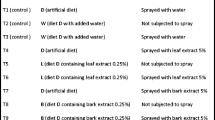Abstract
Hexane and ethanol extracts of seeds from 22 species of plants of the family Meliaceae from a number of countries were prepared. The extracts were submitted to antifeedant and toxicity bioassays utilizing fall armyworm [Spodoptera frugiperda (J.E. Smith)] (Lepidoptera: Noctuidae) larvae and striped cucumber beetle [Acalymma vittatum (F.)] (Coleoptera: Chrysomelidae) adults. Toxicity tests were also performed with brine shrimp,Anemia salina Leach. Feeding inhibition and mortality produced by some of these extracts were comparable to and, in certain cases, slightly greater than the effects produced by comparable neem (Azadiracta indica A. Juss.) seed preparations. Brine shrimp toxicity data do not extrapolate to insect activity, and vice versa.
Similar content being viewed by others
References
Adhikary, S. 1984. Results of field trials to control common insect pests of okra,Hibiscus esculentus L., in Togo by application of crude methanolic extracts of leaves and seed kernels of the neem tree,Azadiracta indica A. Juss.Z. Angew. Entomol. 98:327–331.
Bilton, J.N.,Broughton, H.B.,Ley, S.V.,Lidert, Z.,Morgan, E.D.,Rzepa, H.S., andSheppard, R.N. 1985. Structural reappraisal of the limonoid insect antifeedant azadiractin.J. Chem. Soc., Chem. Commun. 968–971.
Chiu, S., Zhang, X., Liu, S., andHuang, D. 1984. Growth-disruptive effects of azadiractin on the larvae of the Asiatic corn borer (Ostriniafurnacalis Guenee).Kunchong Xuebao 27:241–247;Chem. Abstr. 1984. 101:206062j.
Kubo, I., andNakanishi, K. 1977. Insect antifeedants and repellents from African plants, pp. 165–178, in P.A. Hedin (ed.). Host Plant Resistance to Pests. ACS Symposium Series 62. American Chemical Society, Washington, D.C.
Kubo, I., Matsumoto, T., Matsumoto, A., andShoolery, J.N. 1984. Structure of deacetyl-azadiractinol. Application of 2D1H-1H and1H-13C shift correlation spectroscopy.Tetrahedron Lett. 25:4729–4732.
Ladd, T.L., Warthen, J.D., Jr., andKlein, M.G. 1984. Japanese beetle (Coleoptera: Scarabaeidae): The effects of azadiractin on the growth and development of the immature forms.J. Econ. Entomol. 77:903–905.
Larew, H.G., Knodel-Montz, J.J., Webb, R.E., andWarthen, J.D. 1985.Liriomyza trifolii (Burgess) (Diptera: Agromyzidae) control on chrysanthemum by neern seed extract applied to soil.J. Econ. Entomol. 78:80–84.
Lavie, D.,Jain, M.K., andShpan-Gabrielith, S.R. 1967. A locust phagorepellent from twoMelia species.J. Chem. Soc., Chem. Commun. 910–911.
Lee, S.M., Stone, G.A., andKlocke, J.A. 1985. The comparison of insecticidal activity of U.S. chinaberry (Melia azedarach L.) fruit to Indian neem (Azadiracta indica A.) seed. Agrochemicals Division Abstract No. 76. American Chemical Society Annual Meeting, Chicago, Illinois, September 8–13, 1985. American Chemical Society, Washington, D.C.
Mariappan, V., andSaxena, R.C. 1983. Effect of custard-apple oil and neem oil on survival ofNephotettix virescens (Homoptera: Cicadellidae) and on rice tungro virus transmission.J. Econ. Entomol. 76:573–576.
Meisner, J., Ascher, K.R.S., andZur, M. 1983. The residual effect of a neem seed kernel extract sprayed on fodder beet against larvae ofSpodoptera littoralis, Phytoparasitica 11:51–54.
Meyer, B.N., Ferrigni, N.R., Putnam, J.E., Jacobsen, L.B., Nichols, D.E., andMcLaughlin, J.L. 1982. Brine shrimp: A convenient general bioassay for active plant constituents.Planta Med. 45:31–34.
Nakatani, M., Okamoto, M., Iwashita, T., Mizukawa, H.N., andHase, T. 1984. Isolation and structures of three secolimonoids, insect antifeedants fromTrichilia roka (Meliaceae).Heterocycles 22:2335–2340.
Nakatani, M., Iwashita, T., Naoki, H., andHase, T. 1985. Structure of a limonoid antifeedant fromTrichilia roka.Phytochemistry 24:195–196.
Reed, D.K.,Jacobson, M.,Warthen, J.D., Jr.,Uebel, E.C.,Tromley, N.J.,Jurd, L., andFreedman, B. 1981. Cucumber beetle antifeedants: Laboratory screening of natural products. USDA Technical Bulletin No. 1641, 13 pp.
Reed, D.K., Warthen, J.D., Jr., Uebel, E.C., andReed, G.L. 1982. Effects of two triterpenoids from neem on feeding by cucumber beetles (Coleoptera: Chrysomelidae).J. Econ. Entomol. 75:1109–1113.
Rembold, H. 1984. Secondary plant products in insect control, with special reference to the azadiractins, pp. 481–491,in W. Engels, W.H. Clark, Jr., A. Fischer, P.J.W. Olive, and D.F. Went (eds.). Advances in Invertebrate Reproduction, Vol. 3. Elsevier Science Publishers, Amsterdam.
Saxena, R.C., andKhan, Z.R. 1985. Electronically recorded disturbances in feeding behavior ofNephotettix virescens (Homoptera: Cicadellidae) on neem oil-treated rice plants.J. Econ. Entomol. 78:222–226.
Shorey, H.H., andHale, R.L. 1965. Mass-rearing of the larvae of nine noctuid species on a simple artificial medium.J. Econ. Entomol. 58:522–524.
Taylor, D.A.H. 1984. The chemistry of the limonoids from Meliaceae, pp. 1–102,in W. Herz, H. Grisebach, and G.W. Kirby (eds.). Progress in the Chemistry of Organic Natural Products, Vol. 45. Springer-Verlag, Vienna.
Warthen, J.D., Jr., 1979.Azadiracta indica: A source of insect feeding inhibitors and growth regulators. USDA Agricultural Reviews and Manuals, ARM-NE-4, 21 pp.
Zanno, P.R., Miura, I., andNakanishi, K. 1975. Structure of the insect phagorepellent azadiractin. Application of PRFT/CWD carbon-13 nuclear magnetic resonance.J. Am. Chem. Soc. 97:1975–1977.
Zebitz, C.P.W. 1984. Effect of some crude and azadiractin-enriched neem (Azadiracta indica) seed kernel extracts on larvae ofAedes aegypti.Entomol. Exp. Appl. 35:11–16.
Author information
Authors and Affiliations
Additional information
Mention of firm or product names does not imply recommendation or endorsement by USDA over others not mentioned.
Rights and permissions
About this article
Cite this article
Mikolajczak, K.L., Reed, D.K. Extractives of seeds of the meliaceae: Effects onSpodoptera frugiperda (J.E. Smith),Acalymma vittatum (F.), andArtemia salina Leach. J Chem Ecol 13, 99–111 (1987). https://doi.org/10.1007/BF01020354
Received:
Accepted:
Issue Date:
DOI: https://doi.org/10.1007/BF01020354




